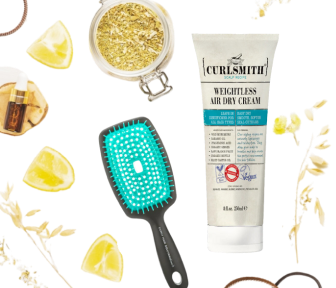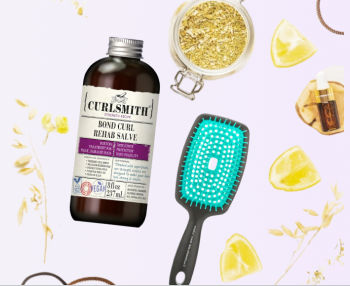Deep conditioning is a popular topic at Curl Warehouse, especially in the winter.
What is deep conditioning?
Deep conditioning is using a conditioner that is left in your hair longer than a rinse-out conditioner. It is usually done with a product that is formulated specifically to be a deep treatment. It is more moisturizing and helps restore the elasticity of your hair. A general rule of thumb is to do this once a month but you may need to do it more often in the winter, and possibly less in the summer.
Why should I deep condition?
Most of us enjoy the almost spa-like experience of doing a deep treatment. The winter air, home furnaces, lots of sun, windy climates, going in and out of the pool or ocean etc. may make you feel that your hair is dry, tangly, rough and dull. That is your signal to consider deep conditioning. If you are using colour/highlights in your hair you will definitely want to deep condition.
There is no reason you can’t deep condition with a regular rinse-out conditioner. In fact you can use a leave-in conditioner as well. For those of you out there who have never found a deep conditioner you like, try using your regular conditioner and just leave it in for 5-10 minutes. Finer textures and low porosity hair generally react best to shorter times and lighter conditioners.
When should I deep condition?
One of the best times to do a deep treatment is after you have clarified. Most of us find that the shampoo that removes product build up (and possibly hard water minerals) can make your hair feel dry. Try to use the deep conditioner on the same day you use your clarifying shampoo.

How to deep condition:
1. Make sure your hair is clean and fully rinsed of shampoo.
2. Apply your deep conditioner. Like all conditioners, give it a minute or two to penetrate before detangling.
3. If you don’t usually brush or comb through your hair when you condition, this is a great time to do it. It will help you get as many individual hairs coated with your product as possible.
4. Once your deep conditioner is in, you can go about your day with a towel around your neck to catch the drips or a shower cap.
 5. If you really want to help push that product into your hair, you can add heat. It can be super simple with a plastic bag or shower cap that will use your body heat to warm up your hair. You can also make this a luxurious experience when you also add in a Hot Heads Thermal Care cap. These caps are heated up in the microwave and will stay warm for 30 minutes. Make sure you still keep a plastic shower cap on your hair so your product has a barrier and the thermal cap stays dry. If you own a hooded dryer this is also a great time to just sit under that and let the heat help your conditioner! Even the steam of your shower will help add heat.
5. If you really want to help push that product into your hair, you can add heat. It can be super simple with a plastic bag or shower cap that will use your body heat to warm up your hair. You can also make this a luxurious experience when you also add in a Hot Heads Thermal Care cap. These caps are heated up in the microwave and will stay warm for 30 minutes. Make sure you still keep a plastic shower cap on your hair so your product has a barrier and the thermal cap stays dry. If you own a hooded dryer this is also a great time to just sit under that and let the heat help your conditioner! Even the steam of your shower will help add heat.
6. Once you are done deep conditioning, rinse your hair fully. It should feel and look amazing! Then go ahead with your regular styling products. You do not need to add any further conditioners.
How often should I deep condition?
This depends on your hair and your climate. I would say once a month in the cold winter and maybe every 6-8 weeks otherwise. You know your hair best and if you are dealing with a lot of damage and using a reparative conditioner, it is perfectly okay to go for once a week.
How long for should I deep condition for?
I mentioned above that even 5 minutes works for deep conditioning. If you are rushed or your hair gets weighed down easily this may be all the time you have or need. 30 minutes is the general rule for most deep treatments, but I have certainly pushed it longer. My only advice is not to sleep with it in as it can make your hair too soft.
What's the difference between a treatment, masque/mask, deep conditioner, etc.?
Generally, there is no difference! Many brands will name their deep treatments different things, but ultimately they all have the goal of moisturizing and/or repairing your hair. These treatments are all designed to be left on for a period of time so that the ingredients can better penetrate your hair strands.
What is 'dirty deep conditioning'?
Dirty deep conditioning is an application method, not a specific product. To dirty deep condition your hair, you apply your treatment or masque of choice on your hair before shampooing, with a little bit of water to ensure it coats the hair evenly and slides through your strands.
This is a popular method of deep conditioning for fine hair or hair that is easily weighed down. You could even use it if you're running short on time or don't want to wander around your house with dripping wet hair while you wait for the mask to soak in. This is also a great option to use up a deep treatment that you think might be 'too heavy' for your hair type.
By applying your conditioner to hair that is dirty, i.e., covered in styling products and hasn't been washed yet, the product does not penetrate into the hair as much. It is more of a superficial moisturizing than a deep one. For some hair types, it might be all you need!
Recommended Deep Conditioners
Deep conditioners can have a mix of protein and moisture or simply be protein-free to provide as much moisture as possible. The protein will be extra helpful for those with damage and for fine hair to give it a bit more strength. You may want to have both types kicking around so you can choose what to go with based on how your hair is feeling that day. Protein also helps your hair stay hydrated by slowing the loss of moisture (water).

Protein-free Deep Conditioners:
Jessicurl Deep Conditioning Treatment
Ecoslay Banana Cream Deep Conditioner
LUS Brands Love Ur Curls Deep Condition & Repair
Deep Conditioners with Protien:
Uncle Funky's Daughter Heal & Renew Intensive Hair Masque
Inahsi Naturals Mango Avocado Resorative Hair Masque
AG Hair Nourish Snow Mushroom Moisture Mask
TreLuxe Soothe & Restore Ultra Moisturizing Deep Conditioner
What ingredients should I look for in a deep conditioner?
The best things to look for to ensure a good deep treatment, based on your individual needs, are:
- Behentrimonium chloride or methosulfate (for slip)
- Fatty alcohols like acetyl and cetearyl
- Emollients (butters & oils)
- Humectants like Aloe Vera, Glycerin (yes glycerin), and propylene glycol
- Hydrolyzed proteins and amino acids if you need protein
Last but not least…
Deep conditioners are designed with ingredients that have a positive charge. This allows them to stick to your hair which is negatively charged. So even fully rinsed hair will still have some of the conditioner left behind. This is what makes your hair smooth, soft, and flexible. These ingredients will stay on until the next time you wash with a shampoo.
It is true that you can over condition your hair, but this is tough to do if you live in a very dry climate. If your hair turns out too soft and is no longer holding your waves or curls, consider going with:
- less time
- a lighter conditioner
- less oils or
- some or all of the above.
If you aren’t seeing the results you want - meaning your hair it isn’t any softer or more manageable - then you can:
- increase your length of time (shouldn’t really need more than 30 mins though)
- add heat as suggested above
- get a conditioner with more oils, fatty alcohols, and butters and less protein, unless you need it (i.e., hair is colour-treated, frequently straightened, bleached, etc.)
For low porosity hair that experiences a lot of build up, consider a pre shampoo oil treatment instead of, or in addition to, the occasional deep treatment. You can read my blog about Oils and Your Hair here.
Like styling products, finding the right deep conditioner may take more than one attempt. Try out travel sizes first or experiment with leave-in and rinse-out conditioners you already have at home to see how your hair reacts to frequency and time left on your hair.
Keep in mind that if you're regularly battling dryness and frizz, it may be less about the product you use and more about your consistency in using it!
References
http://science-yhairblog.blogspot.com/2014/01/deep-conditioning-part-i.html
http://science-yhairblog.blogspot.com/2014/01/deep-conditioning-part-ii.html








